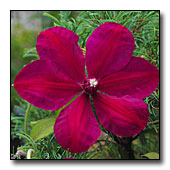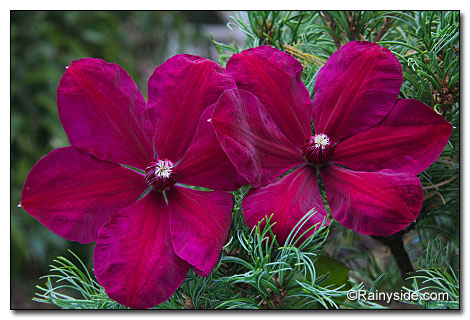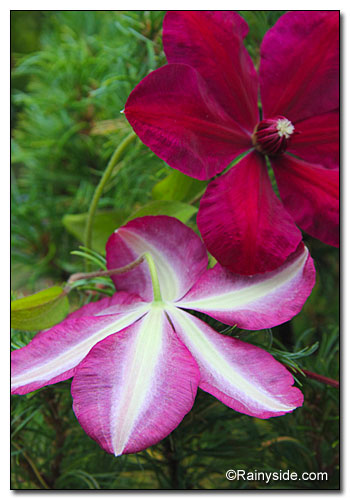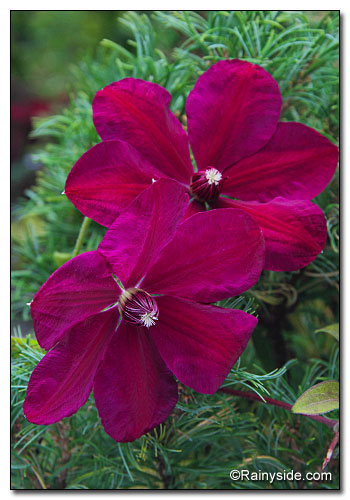Clematis 'Westerplatte'
Family: Ranunculaceae
Pronounced: KLEM-uh-tiss

Quick Jumps
Growing Guide
Rainy Side Notes
GROWING GUIDE

Origin:
Garden.
Plant group:
Vines.
Hardiness:
Sunset zones: All.
USDA zones: 4-9.
Heat zones: .
Mature size:
Height: 3.25-6 feet (1-1.8 m).
Flowering period:
First flush of flowers in the spring, and second flush in late summer to early fall.
Flowering attributes:
4 to 5-inch flowers have overlapping, deep rich rose-red tepals with recurving tips and red bars down the center. Red stamens and creamy white to yellow anthers offer a handsome contrast with the flower petals.
Leaf attributes:
Deciduous, green leaves.
Growth habit:
Climbing.
Light:
Full sun to partial shade.
Soil:
Fertile, humus rich, well-drained soil.
Feeding:
Mulch well with composted manure or compost. Fertilize once a month with a complete organic fertilizer during the growing season.
Propagation methods:
Layer branches in late winter.
Basal and softwood cuttings in spring.
Division in spring.
Semi-ripe cuttings in early summer.
Pruning methods:
Pruning group 2 or B.
Rainy Side Notes


Well-known for many clematis introductions, Brother Stefan Franczak—a Jesuit monk of Warsaw Poland—raised this clematis of unknown parentage, and introduced it sometime around 1964. He named it C. ‘Westerplatte’ to honor a historic event where Polish armed forces defended the Westerplatte Peninsula against the Nazis for seven days. Westerplatte now symbolizes soldiers’ heroic deeds.
The stunning two-tone red gives the flowers a multi-dimensional look. When I first saw the blossoms, the sensuous hues of rose-red and a dark velvety red seemed to change depending on the direction you looked at it. The word hologram came to mind as a way to describe the lovely tepals. It is well on its way to becoming one of my favorites to grow.
The vine climbs to only six feet, making it suitable to clamber up a lamppost, shrub rose, or trellis, in addition to adapting well to container culture. I recommend placing two of the same vines into one container for a fuller look.
You can get two flushes of flowers on this vine by being mindful of your pruning. After the spring flowers fade, prune back the tops of no more than ½ the stems, which will encourage new growth and a second flush of flowers.
This clematis is not only resistant to insects and diseases, the bright red flowers pack a lot of wow-power into the landscape!
Photographed in author's garden.

Gardening for the Homebrewer: Grow and Process Plants for Making Beer, Wine, Gruit, Cider, Perry, and More
By co-authors Debbie Teashon (Rainy Side Gardeners) and Wendy Tweton
Copyright Notice | Home | Search | Vines

